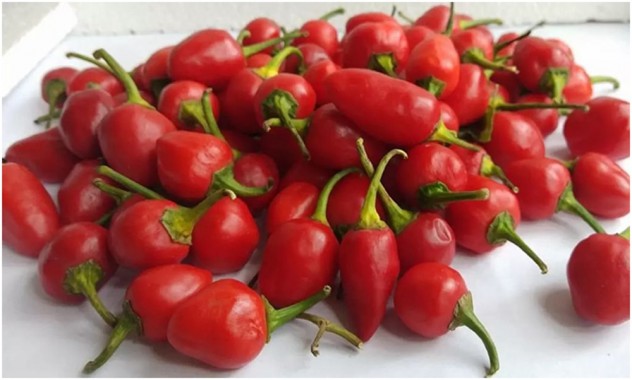




















Sunday, Nov 01, 2020 12:45 [IST]
Last Update: Sunday, Nov 01, 2020 07:03 [IST]
MAHESH DAWARI
Red cherry pepper (Capsicum annumvarcerasiforme), locally known as Dalle Khorsaniin Sikkim is well known for its unique taste, flavor and pungency. Dalle khorsani is mostly cultivated in mid hills of South, West and East Districtsof Sikkim and adjoining in the Darjeeling district of West Bengal.The crop was firstly grown commercially inNamphok,South Sikkim by Mr. Nanda LallDawari in the year 1996 with approx. 600 saplings. Later it was sold in the nearby market in Rabongla and Singtam haat bazars. Because of its unique taste and flavour now tourists from all over the globe loves to purchase dalle as the “Gift of Sikkim”.
The dalle crop belong to the family solanaceaeand genus capsicum.Dalle can cultivate upto 100 to 130 cm height under open field and 150 to 180 cm height in the green house. Each plant produce 2.5 to 3.0 kg fruits with about 500 to 1000 pods.This crop can be grown throughout the year under the protected condition. The Scovillescore (pungency level) of this chilli is rated in the range of 1, 00, 000 to 3, 50 000 SHU. Now it has become a valuable cash crop of Sikkim since it is valued for its diverse commercial uses. Dalle Khorsani is a round cherry size, bright red when fully ripen, full ripen fruits are use in pickles sauces and paste making process. Dalle processing was initially started in Rabongla by Mr. Samir Tamhane with the brand name of High Altitude in the year 1998.Later “Sikkim Supreme” a government food preservation factory started production in Singtam East Sikkim in the year 2000.Then farmers started commercial production for Sikkim Supreme and High Altitude brands. In the year 2007 new unit setup at Lower Sichey,Gangtok with the brand name of “Sikkim Greengrocer” for the production of dalle chilli pickles and paste. Bit t by bit dalle became popular in national and international market. And in the year 2015 M/sGreengrocer started production of dalle sauce with the brand name of “peero”(a global registered trade mark). This product gave great value of dalle khorsani and could reach dalle to national and international markets. The 180-years old American company Tabasco senda legal notice to Greengrocer for product design copyright issues, which were later resolved.
Recently,the World Trade Organization gave Geographical Indication Tag for the dalle to Sikkim, which is a matter of great of pride for Sikkimese farmers.
Dalle khorsani of Sikkim is a pungent chilli but has many medical properties. Dalle chilli contains Capsaicin which produce different pungent level as well as carotenoids and phenolic compounds and is being used as natural pigment and antioxidant agents. However,the Scovillescale indicates that its pungency is very high.
Dalle khorsani are high in vitamin -A vitamin- E and potassium and low in sodium. One hundred grams of fresh dalle khorsani has 240 gm of vitamin –E, vitamin –C issensitive to heat and drying but vitamin A is very stable and paprika and dried chilli both contains relatively high amount of this important nutrient.
Pepper is well known for their health benefits. Herbalists have long promoted pepper for their health enhancing effects. These includes clearing the lungs and sinuses protecting stomach by increasing the flow of digestive juices , triggering the brain to release endorphins (natural painkiller) making the mouth water ,which helps to neutralize cavity causing acids and help protect the body against cancer ,through antioxidant activities. Recently Swami Ram Devjiand Acharya BalKrishnaji are promoting health benefit of dalle on various TV programmes, this indicates the great future of dalle in near future. Patanjali has also launched dalle pickles and sauces withHOT Hill brandfor its own stores.
Method of production:
Soil and climate
Red cherry pepper prefers warm and humid climate.The crop can be tolerate high temperature and cannot withstand heavy rain during growth, flowering and fruit set. Very cold weather less than 12 c* during the night also hampers growth and fruit set. Ideal temperature for flowering are 20-25c*.It can be also cultivated in wide range of altitude and soil, sandy loam soil with ph of 5.5 to 7.5 is ideal. Water stagnation is detrimental to the crop. Highly acidic soil need to be reclaimed using limestone or dolomite.
Land preparation:
The main field should be ploughed 3-4 times for the fine filth .Farm yard manure is incorporated during last plughing. Cow urine can also be use for drenching for soil preparation.
Nursery Management
Site should be elevated place and preferably near the planting site .it should be sunny, near to the water source and land should be well drained and nursery bed should be made near partially shaded area.
Nursery can be raised under the protected structure like poly house and net house. Bed should be prepared by mixing FYM@7kg/M2Neem cake @2kg/m2vermicompost @1kg/m2. Thecontinent size of bed is 1m x 1m, sufficient space for the central path and inter bed path to carryout intercultural operation.
Mulching is done with dry leaves, paddy straw and black polythene for early germination. Weed should be removed regularly from beds and frequent watering should be done.Damping off is the most common diseases which can be managed by applying Tricodermaviridis and Psedomonasfloreseens culture @10gm/liter but in the sever case drenching with Ridomil / Matco @3gm /liter is also advisable.
Transplanting
Generally 30-35 days old seedling is ready for transplanting. It is better to keep seedling in open condition a day before transplanting. Transplanting should be done in the afternoon.
Planting
Dalle khorsani can be grown round the year if proper care is taken under protected condition. It prefers warm humid climate during early stage and dry weather towards maturity of pods .It can be grown up to 500-1400m above mst.Excessiverainfall causes defoliation,rotting of pods and with incidence.Normally crop is planted in March –April. The optimum spacing for this crop is 1m/1m and planting should be preferably being done raised bed. Water stagnation in the field causes serious damages to the crop.
Nutrient Management
Nutrient management is done through organic sources with the use of different nutrient rich manures and growth promoter .The recommended manures and bio fertilizer for dalle khorsani is as follows.
Source Dose Application Time
FYM 20t/ha(2kg/plant) soil 15 days before planting
Neem Cake 2t /ha(20g/plant) soil 7 days before planting
AzosprillumPSB 20%(200g /l )root dip for 15 minutes Seedling treatment At planting
Vermicompost 2.5 t/ ha 250g /plant Soil treatment 20 days after planting
Bio NPK 0.3%(3ML/L) Foliar spray 30 days after planting
Boron (multiplex) 0.2%(2g /l) Foliar spray 30 days after planting
Miraculon 0.05%(0.5ml/plant) Foliar Spray 20&40 days after planting
Cow Urine 20% (urine :water 1:4) Soil drench At 20 days interval
Intercultural Operations
Manual weeding should be done. Gap filling is done during second irrigation 10 days after transplanting. Light hoeing is required to remove weeds and loosen soil for better aeration and root growth. In order to boost vegetative growth, fruit set and yield, buds from the first and second nodes are pinched off. Unproductive branches below first nodes are also clipped in cooler season especially when sunscald is not a problem. Tall growing chilli needs staking to prevent lodging due to fruit weight. Earthling – up of the plots should also be done after 30-45 days of planting. Dried leaves, paddy straw, saw dust can be used for mulching. Black polythene sheet (mulching plastic) is the most preferable mulch material for this crop.
Irrigation
A Continuous supply of optimum water is essential for proper growth and fruit yield. The first irrigation should be given immediately after transplanting and water should be provided at weekly interval. Heavy irrigation is avoided because it causes soil borne diseases like wilt and collar rot.
Plant Protection
Aphids (Aphis gossypii and Myzuspersicae), locally called as Lye Kira, attack the sap and reduce the vigour of the plant and secrete honey dew which attract ants and develop sooty mould in the lower part of the leaf. They also act as vector for viral diseases. Application of systemic bio-pesticides like Verticilliumlecani petroleum base oil sprayp@6 ml/lit is recommended. Fruit fly also attack the plant. They lay eggs in the fruits an after hatching, maggot starts feeding on fruits resulting fruit drop. Placing of 8-12 pheormone traps per ha at the time of fruit set and collection and destruction of dropped fruits manages the problem.
Harvesting
The plant starts flowering after 70-80 days of planting and first picking is done at ripening stage. It continues to bear fruits for 2-3 years. While picking the fruits lifted gently off the plant without causing injury or breakage of stem. Dalle is sensitive crop, it has to be processed within a week, it can dry in sun and used as chillipowder.
Dalle has great future aspects; it can replace the use of normal chilli, as it has no side effects and have many medical proprieties. Many global companies have shown interest in dalle cultivation.
